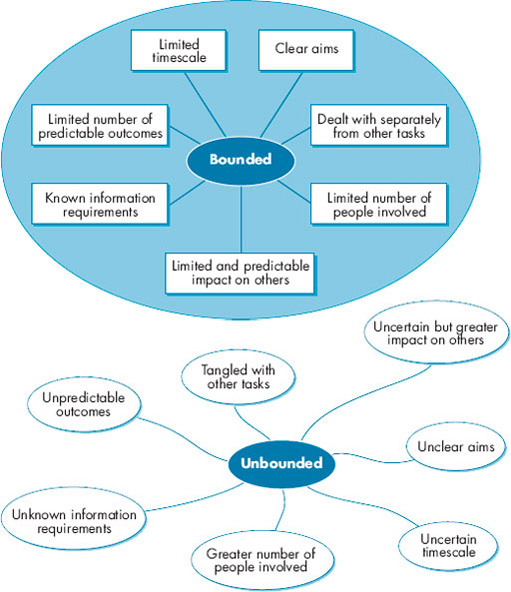3.2 Bounded and unbounded tasks
Another way of tackling tasks and problems, particularly judging how much time you will need to spend on them, is to assess how simple or complex they are. Here we distinguish between bounded and unbounded tasks or problems. Bounded tasks are typically small scale, well defined and relatively uncomplicated; unbounded problems are larger scale, poorly defined and generally quite ‘messy’. Figure 11 paints a more detailed picture of the differences.

The two key differences between bounded and unbounded tasks are in the size of the task and the degree of uncertainty involved.
The size of a task relates firstly to the length of time it takes to do. Unbounded tasks will always take longer to do than bounded tasks, so bear that in mind in any time planning you may do. Size also relates to the number of people and the volume of other resources involved in doing the task and the number of people affected by its outcome. Unbounded tasks, again, tend to involve and affect more people than bounded tasks.
The degree of uncertainty is more difficult to explain but a way to understand it is that unbounded tasks tend to need more thinking time than bounded ones. In unbounded tasks you will need to figure out for yourself:
what your aims are
what information you need from whom or where
what results or outcomes you would find acceptable
when to finish.
In bounded tasks, however, many of these things are decided for you by your manager or workplace routines.
In reality, of course, most work tasks aren't quite as clear-cut as this and the ideas of the bounded and the unbounded are at either end of a kind of sliding scale, where we can say some tasks are relatively bounded or relatively unbounded. In the workplace, we can say that routine administrative tasks or one-off letters, memos, emails and phone calls are examples of relatively bounded tasks, whereas team-leading roles or projects, events and exhibitions for which you have some organising responsibilities are relatively unbounded. Or to take some domestic examples, we could say that cleaning a room is a relatively bounded task (although if it is your teenage child's room it might not feel like that!), whereas organising a group or family holiday is relatively unbounded.
Case study: Supply and demand: Part 2 – The Head Teacher's story
My name's Mary Jackson. I have been the Head Teacher at Longheath School for three years now. It's a mixed comprehensive in a socially disadvantaged area of Castletown. When I was appointed, the school had received an unfavourable Ofsted [official body which inspects schools] inspection. The previous Head had resigned and many long-serving staff had moved on, too. Since then we have all worked hard to turn things around.
When I was appointed Head, I didn't fully appreciate the scope and scale of the responsibilities of the role. I have been teaching long enough to remember when heads were just the most senior teacher. But the role I took on in the wake of the poor inspection result is a lot more about managing the school towards continuous improvement in the interests of our students. For example, I am responsible for an overall School Improvement Plan which is reviewed and evaluated on a regular basis. This checks whether we are reaching the targets set in various action plans.

However, it is also my responsibility to manage our limited resources as well as possible. I have to be a finance manager and a personnel manager, as well as a figurehead and a leader for the school. I am really quite concerned about the amount of money we have had to spend on supply teachers over the last year or so, particularly in relation to the vocational A levels. It's especially frustrating when many of the supply teachers do not seem very bothered about the quality of the learning that occurs in their sessions.
Alongside the many pressures, the job also gives me a sense of personal reward and I'm pleased to say that our inspection last year was generally favourable. There was, however, some concern expressed about the quality of teaching on our vocational A-level programme, especially in health and social care. Unfortunately, it is precisely this area where I have found it hardest to recruit good teachers. This has meant that I have had to manage with a succession of supply teachers, some of whom have worked out better than others.
Our last health and social care supply teacher decided that she wanted a school in what she described as a ‘nicer area’. I didn't ask too closely what she meant, but it's a comment we still get from time to time. So, I had to make another call to the supply agency. My contact there is Roger Mannering. Roger explained that they were very short of teachers who could offer health and social care. I was just about to put the phone down when he noticed that they had only just had a new person come onto their list, Kiran Sangha. She might be a possibility, at least she's had some experience, even if it was years ago. And in any case, it's Friday afternoon and I need cover next week. I agreed to give Mrs Sangha a phone call and see if she was prepared to teach at Longheath.
Activity 5
This activity asks you to identify a range of management issues facing Mary in her role as a head teacher. You may need to remind yourself of these again by quickly reviewing Sections 2 and 3 respectively.
Write a short paragraph of at least two sentences to answer each of these questions. Then compare your two paragraphs with those in the discussion below.
What issues of efficiency and effectiveness does Mary have to consider when appointing supply teachers?
In deciding to approach Kiran about the post, what is the balance between urgency and importance?
Discussion
You may have identified some of the issues of effectiveness in this part of the case study. They are mainly to do with the quality of teaching staff and how the supply teachers contribute to the school's improvement of its results and Ofsted rating. Quality is clearly an important consideration in Mary's work, given the school's poor ratings in the past. The efficiency issues may not be as obvious. They are to do with having the right number of staff in place to meet the needs of the school's pupils and the teaching timetable.
To an extent this also relates to the balance of urgency and importance. Although Mary urgently needs a new health and social care teacher, it is important to her and the school that the person is suitably qualified and experienced. It is also important that the person is committed to the pupils and can help the school improve its record in this subject area.
While your two paragraphs might not match the two above exactly, this does not matter too much. The most important thing is that you have managed to write a short but readable answer, which touches broadly on the same issues, in the form of a paragraph. Paragraphs are the building blocks of essay writing. We will consider how they can be put together to help write an essay later on in this block.
Case study: Supply and demand: Part 3 – Kiran's response
I had just returned from collecting the children from school. I was putting the key in the front door and heard the phone ringing. Why does the phone always go at the most awkward times? I asked Akaash to put the telly on and get a glass of juice for himself and for Vanita while I answered. I picked up the phone.
‘Hello, Mrs Sangha?’ I didn't recognise the voice. ‘This is Mary Jackson from Longheath School. I understand from the agency that you're available as a health and social care teacher. Could you start on Monday?’
I hesitated for a moment. I guess Mrs Jackson must have sensed my hesitation, she's probably dealt with lots of supply teachers. She continued, ‘Look I know it's short notice, we can probably cope on Monday. I see you've been away from teaching for some time. Would it help if you came in on Monday to discuss this? With a view to starting on Tuesday.’
I didn't want to put her off, so I agreed to meet on Monday.
Activity 6
It is clear that Kiran has a number of things to do and decisions to make over the next few days. All of them are fairly urgent because of the limited time available to her.
Draw up a ‘To Do’ list for her, including the decisions she must make over the weekend before she has her meeting with Mary on Monday.
Assuming that she is going to start work, what other tasks will she have to do before she comes into work on her first day?
For each item on the ‘To Do’ list give the most important the number ‘1’, the second most important the number ‘2’, and so on until you have created a priority listing.
Discussion
Kiran really needs to have a ‘toolkit’ of resources to see her through the first few days. This might include the ability to prioritise decisions and her ability to manage herself and her time. Setting down the demands and the time available to meet them can be a useful way of clarifying the workload and making it possible to prioritise and go about them in a reasonable way. She might need to consider the following demands:
prepare sessions for the first few days
arrange for collection of Akaash and Vanita from school
decide what to wear!
sort out family meals
buy a diary
make a time plan.
